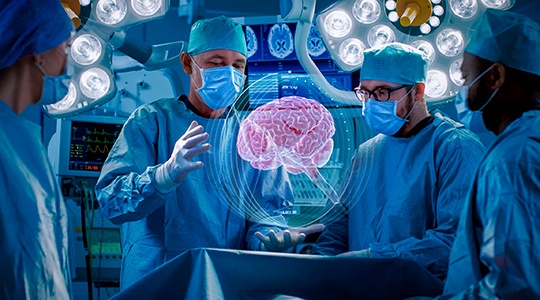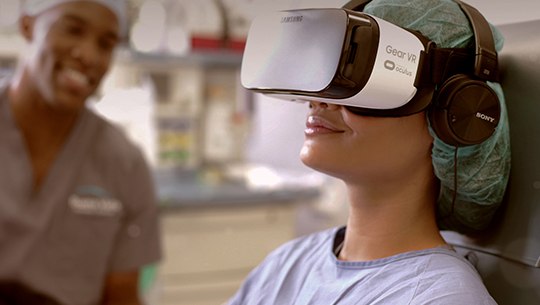AR in the healthcare industry is already a big hit and used globally. In this article, we will show you why this is, and help you get started with AR app development.
Augmented reality technology has rapidly become a transformative force within the healthcare sector, achieving global acclaim for its innovative applications. In the forthcoming discussion, we aim to elucidate the reasons behind the widespread adoption of augmented reality in healthcare settings and offer insights into initiating collaborations with an AR app development company.
The current health crisis has prompted countries around the globe to increase their investments in healthcare infrastructure, with a keen emphasis on adopting cutting-edge technologies. Among the array of technological advancements revolutionizing the medical industry, augmented reality stands out for its ability to merge digital information with the physical environment, enhancing the delivery of medical services. Unlike VR in healthcare, which provides immersive experiences, augmented reality offers a more universally applicable solution by overlaying digital data onto the real world.
For those new to augmented reality in medicine, it may be a surprise to learn about its extensive application and acceptance across the medical community. This technology, one of the pillars of extended reality alongside VR and MR, is reshaping patient care, medical training, and surgical procedures by providing real-time information and 3D visualization capabilities. The integration of augmented reality in healthcare improves the accuracy of diagnoses and treatments and enhances the learning experience for medical professionals.
Understanding the potential and the mechanics of augmented reality can be pivotal for healthcare organizations looking to stay at the forefront of medical innovation. By partnering with a specialized AR app development company, healthcare providers can develop customized solutions that address specific challenges within their practice, thereby improving patient outcomes and operational efficiency.
What Is Augmented Reality in Healthcare?
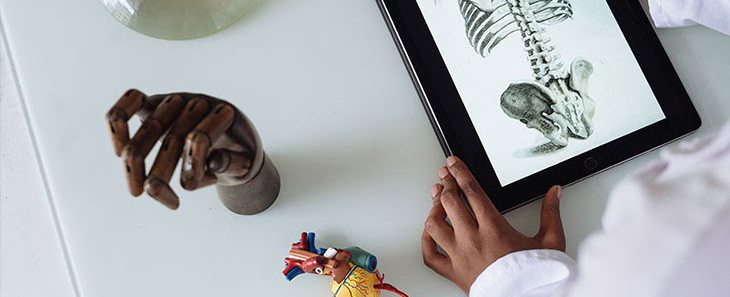
Augmented reality in healthcare marries advanced digital visuals with real-world clinical settings, providing an interactive layer of information that enhances medical procedures and education. This fusion allows healthcare professionals to see beyond the surface, offering insights and data overlaid onto their physical environment, which can significantly improve the precision and effectiveness of medical interventions.
- Patient care. By projecting vital, real-time data onto the healthcare professional's field of vision, augmented reality facilitates a deeper understanding of patient issues, enabling more accurate diagnoses and the development of tailored treatment plans that lead to improved health outcomes.
- Surgical precision. Surgeons utilize augmented reality to access three-dimensional representations of the patient's anatomy during procedures, allowing for more precise and less invasive interventions. This advanced visualization can reduce operative risks and enhance recovery rates.
- Medical training. Augmented reality revolutionizes medical education by providing interactive, hands-on experiences without the risks associated with real-life patient interactions. Trainees can perform virtual procedures, gaining invaluable practical skills in a controlled and safe environment.
Augmented reality's integration into healthcare is transforming the field, offering innovative solutions that bridge the gap between traditional practices and futuristic possibilities. As medical augmented reality technology evolves, its application in medicine broadens, promising to refine further and enhance the quality of healthcare delivery and education.
How Augmented Reality Is Used in Healthcare
A variety of cases illustrate the effective incorporation of augmented reality into the field of medicine, each aimed at a shared goal: to elevate the standard of healthcare services. Such advancements are made possible by the unique functionalities provided by augmented reality technology. Using a device's screen and camera, augmented reality technology captures the user's surrounding environment and enriches it with digital elements, thereby offering a composite view that blends the real with the virtual.
The integration of AR in healthcare has opened new avenues for enhancing patient care, surgical precision, and medical education. By superimposing digital information onto the physical world, medical professionals can access a wealth of data and visual aids at their fingertips, leading to more informed decision-making and improved patient outcomes.
One of the most notable applications of augmented reality in healthcare involves its use in complex surgical procedures. Surgeons can now visualize the intricate details of a patient's internal anatomy in real-time without invasive exploratory surgery. This improves the accuracy of interventions and significantly reduces the risk associated with surgeries.
Moreover, augmented reality has transformed medical training and education. Traditional methods of learning, which often involve textbooks and cadaveric dissections, can now be supplemented with interactive, augmented reality simulations. These simulations allow medical students to practice and refine their skills in a risk-free environment, thereby bridging the gap between theoretical knowledge and practical expertise.
In patient care, augmented reality applications assist healthcare providers in explaining complex medical conditions and treatment plans to patients. By visualizing their conditions through augmented reality, patients can better understand their health issues, which in turn can lead to higher engagement in their treatment process and improved compliance with medical advice.
As augmented reality continues to evolve, its potential in the healthcare sector is boundless. With each innovation, augmented reality brings us closer to a future where medical care is more accessible, precise, and personalized, ultimately revolutionizing how we approach health and medicine.
Reusable endoscopes are used in approximately half a million gastrointestinal medical procedures every year. Without proper cleaning, this poses a threat to patients, as they could transmit infections from one to another.
To address such a risk, the Riverside Health System in Virginia, U.S.A. created a helpful augmented reality app. The app works by visualizing cleaning techniques and providing simple step-by-step instructions for the staff to repeat.
A practical tool during surgery
There are already several augmented reality applications out there that help with complex surgery procedures. For instance, they can either show surgical instructions through augmented reality goggles or a regular smartphone. The idea behind augmented reality surgery is to show an overlay image where the operation should take place, based on MRI and CT scans from the patient.
One example of such a tool is being used in JFK University Medical Center, where surgeons are aided by the app in visual navigation. This tool has successfully managed to pair a surgical microscope with a 360° visualization platform and provide vital bodily information in a matter of seconds.
A patient education/presentation tool
Doctors and nurses have an important role in educating and reassuring patients, but there are certainly cases when this learning process can happen without their participation.
For example, patients can now learn about the procedures and see how their vision might improve after surgery with a special solution deployed at the Translational Medicine Research Center in Istanbul. Such an approach definitely fosters overall medical education. In this case, the visuals were not generated by a smartphone, but rather a special projector and lens that create an immersive hologram.
Telemedicine software is becoming increasingly popular because it opens the door for patients to receive much of their care remotely without hospital visits. Augmented reality is starting to dominate this field of development because of the technology’s capacity to capture footage with a camera.
We can see this type of solution applied by G60 Trauma, a private healthcare firm in Arizona that provides patients with augmented reality nursing through a virtual assistant. The assistant scans and interacts with the patient, performing checkups and identifying issues with posture.
Hospitals can be a scary place but become even more so when their layout is complicated and mazelike. At least, this is what it often feels like for kids.
In an effort to address the issue, the Children’s Health Centre in Surrey, Canada built a fun augmented reality app for kids. It features a colorful squirrel named Chip that helps children find their way through this hospital.
When paired with machine learning, augmented reality produces incredible results because of its ability to detect some of the most dangerous diseases very quickly. At least, this was the case with a study conducted in multiple countries by researchers using a so-called augmented reality microscope.
The hospitals involved in the research didn’t have to change their existing microscopes, since digital cameras captured the footage and fed the results to a custom AR display and ML algorithm. Augmented reality, combined with machine learning outperformed even the top trained pathologists in identifying various health defects.
A solution for medical staff cooperation
Cooperation between medical staff in different locations is extremely important in situations where one side lacks critical expertise. Some solutions in this field exist, but augmented reality can improve the experience by making visualizations realistic and helpful in where they are displayed.
This system is being tested in military settings by researchers from Purdue University working closely with army medics. A person performing a medical procedure wears a headset that transmits footage to medical staff. They can then remotely annotate the screen with live information and guidance.
Still hesitating about implementing AR in your healthcare app?
Check out the benefits of augmented reality in healthcare!
The transformative impact of AR in healthcare and medical education is profound, offering many benefits that enhance learning and patient care. Here's an expanded overview of the key advantages of adhering to the specified formatting:
- Enhances medical education. AR in healthcare serves as a dynamic educational tool, significantly enriching medical training. Through AR, learners can interact with detailed three-dimensional models of human anatomy, gaining a deep understanding of complex structures within the body. This interactive approach makes learning more engaging and improves knowledge retention, ultimately elevating the standard of medical education.
- Improves surgical visualization. The application of augmented reality in medicine provides critical advantages during surgical procedures. By overlaying patient-specific 3D models onto the actual surgical field, surgeons gain real-time, enhanced visualization of the area of interest. This augmented perspective aids in achieving greater precision during operations, potentially reducing complications and enhancing patient recovery outcomes.
- Educates patients effectively. Augmented reality transforms patient education by making complex medical information more accessible and engaging. Through AR, patients can visualize their health conditions and treatment options, leading to a clearer understanding of their medical situation. This clarity supports informed decision-making and encourages active patient participation in their healthcare journey.
- Facilitates navigation within facilities. Managing large healthcare facilities can be daunting, especially for first-time visitors. Augmented reality eases this challenge by providing interactive maps and directions through users' smartphones, simplifying the process of reaching destinations within hospitals and reducing the stress associated with hospital visits.
- Enables remote consultations. In the context of telemedicine, AR in healthcare has proven invaluable. Patients can interact with virtual healthcare professionals from the comfort of their homes, allowing for remote consultations and care. This not only broadens access to medical advice but also minimizes the risk of exposure to infectious diseases.
- Assists in early disease detection. Combining augmented reality with advanced diagnostic algorithms enhances the early detection of diseases. AR can project visual representations of data from diagnostic tests, helping medical professionals identify abnormalities or changes in disease activity early, leading to timely interventions and better disease management.
- Revolutionizes medical training. Augmented reality has redefined medical training by offering safe, virtual environments for practicing complex procedures. This risk-free setting allows medical trainees to learn from mistakes without real-world consequences, reducing the learning curve and building confidence before performing procedures on patients.
Augmented reality is making a significant impact on healthcare, particularly in medical education and clinical practices. Its broad applications range from enriching medical training to improving patient care, heralding a future where healthcare is more efficient, effective, and patient-centered. As exploration and adoption of AR continue, its role in healthcare is set to become even more central and influential.
What Are the Best AR Medical Apps?
With augmented reality development on the rise, many great AR medical apps are already available to use, and they can be useful to both sides — patients and medical personnel. Let’s review some of the best AR health apps out there:
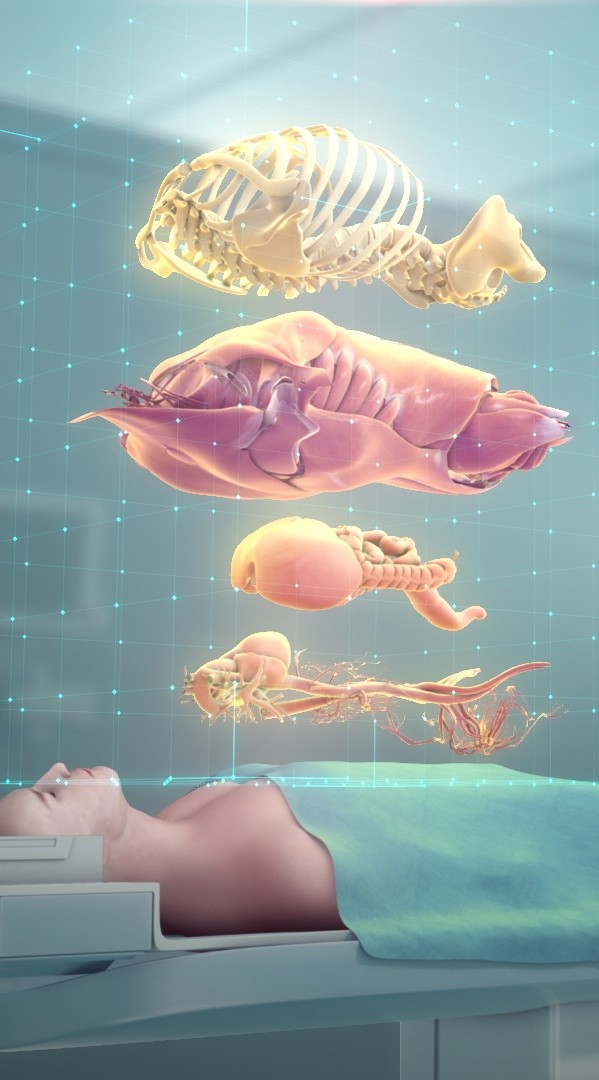
- ARnatomy – As the name suggests, this is an app dedicated to helping people learn about the human body. It’s very simple to use and people can even scan their own bodies to see the anatomy. It was primarily developed for students to get more familiar with human biology.
- smARtsKin – This is surely one of the best augmented reality apps for healthcare in the field of cancer treatment. When a patient undergoes radiotherapy, they must be placed in a specific body position. This application uses augmented reality technology in combination with cameras as guidance for patient positioning which improves their safety drastically.
- Dorothy – A solution for people with memory problems. Users are reminded about their daily tasks and they are guided around the house if they can’t remember the way. If a user goes somewhere on their own, their caregiver is notified via live alert, which is super useful in cases of Alzheimer’s.
- AccuVein – It’s a pioneering AR healthcare app that enhances patient care by allowing clinicians to view superficial vasculature, including veins, valves, and bifurcations, typically unseen. This technology improves needle placement, reduces IV complications, and boosts procedure efficiency, leading to increased patient satisfaction and enhanced clinical performance.
- AR Eye – Would you love to know how visually impaired people see the world? With this application, you can see how it would look if you had eye disease such as glaucoma. Other than that, you are also able to explore the human eye by learning about the parts that make up our eyes, which undoubtedly spurs medical education.
Are you looking for a team of experts who can create an application like that?
What Is Development Like for AR Healthcare Apps?
The prospects for augmented reality in the domain of medicine and healthcare are promising, yet the path forward is not without its hurdles. To integrate an AR application into the healthcare system, it must adhere to stringent medical regulations designed to safeguard patient well-being.
Furthermore, the accuracy of the information presented through such applications is paramount; any discrepancies or errors could lead to adverse effects on patient health, underscoring the critical nature of precision in developing and deploying AR solutions in healthcare settings.
The complexities involved in creating AR applications for medical purposes become evident through practical examples, such as developing our Hand Rehabilitation VR training program. This innovative application is designed to assist patients in enhancing the mobility and functionality of their hands post-injury or surgery.
Through the use of haptic gloves and VR headsets, patients engage in a series of exercises aimed at expanding their range of motion in a controlled and gradual manner. Central to this experience is a virtual guide named Andy, who demonstrates the necessary exercises, ensuring that patients perform them correctly to maximize rehabilitation outcomes.
Augmented reality in healthcare is redefining the approach to patient care and treatment, offering immersive and interactive experiences that were previously unimaginable. Specifically, in the realm of physical rehabilitation, AR technology has shown immense potential. By simulating real-life movements and tasks within a virtual environment, patients can safely practice and regain their abilities, making AR a valuable tool in the recovery process.
Furthermore, the integration of AR in healthcare extends beyond patient rehabilitation, offering applications in surgical planning, medical training, and patient education. By overlaying digital information onto the physical world, AR provides healthcare professionals with enhanced visualizations, critical data, and interactive training modules, thereby improving the efficiency and effectiveness of medical interventions.
As the application of augmented reality in medicine continues to evolve, it holds the promise of transforming healthcare delivery. However, the journey towards widespread adoption is accompanied by the need for meticulous development, rigorous testing, and adherence to healthcare standards to ensure that these innovative solutions not only enhance medical care but also maintain the highest levels of patient safety.
All-in-One Telemedicine App - Explore Our Latest Portfolio Project
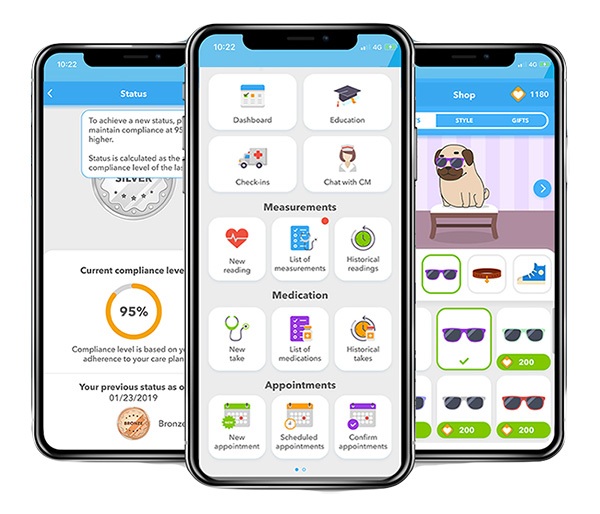
Track your health, chat with your doctor, schedule appointments and don't forget to take your pills! Program-Ace developed an all-in-one solution for people who want to live healthy and active lives.
One of the most formidable hurdles we encountered in developing our application lay in the intricacies of coding for exacting motion tracking capabilities. The nuanced nature of hand rehabilitation requires the system to detect even the minutest movements, as therapeutic exercises often involve subtle motions. To achieve the requisite sensitivity and precision, our team undertook extensive physical testing, iterating and refining the technology to ensure it could accurately register the full spectrum of hand movements essential for effective rehabilitation.
Moreover, our commitment to creating an augmented reality experience that stands on par with traditional rehabilitation methods led us to invest considerable effort into research within the rehabilitation sector. This foundational work informed the development of a rich array of animations, sounds, 3D models, and visual effects, each meticulously crafted to replicate the nuances of real-life rehabilitation exercises. Our objective was to ensure that augmented reality in healthcare not only matched but potentially surpassed conventional rehabilitation experiences in terms of engagement and effectiveness.
The adoption of AR in healthcare, particularly in physical therapy and rehabilitation, represents a groundbreaking advance. By leveraging augmented reality, we can offer patients a more interactive and immersive rehabilitation journey, one that combines the benefits of traditional therapy with the enhanced capabilities of digital innovation. In our pursuit of excellence in AR in healthcare, we have focused on creating a system that is not only technologically advanced but also deeply rooted in medical research and best practices.
Augmented reality's role in medicine extends beyond rehabilitation; it is reshaping how medical professionals approach patient care, surgical planning, and medical education. By incorporating augmented reality into healthcare, we unlock new possibilities for treatment and recovery, offering patients a more engaging and practical therapeutic experience. Our dedication to overcoming the technical challenges associated with augmented reality in medicine reflects our broader commitment to enhancing healthcare outcomes through innovation.
How to Get Started with Your App?
TTo have a smooth experience with your AR application, you have to meet certain requirements. These requirements include hardware, software, and people who will develop the application.
Hardware
In the hardware aspect of augmented reality deployment, there's a diverse array of options ranging from commonly used smartphones to specialized immersive devices such as headsets and goggles. Opting to develop applications for smartphones taps into their widespread usage, ensuring that augmented reality in healthcare is accessible to a large audience. This approach greatly expands the reach and impact of AR in healthcare by making it available to most users. Conversely, focusing on specialized equipment like headsets offers a more immersive and detailed experience, particularly advantageous in medical education and complex diagnostic procedures.
Focusing on specific hardware, the Hololens headset is a notable example, widely utilized in medical contexts. It serves as an essential tool for surgical teams, fostering a collaborative environment in critical medical settings. Although Hololens is technically classified under mixed reality, its functionality and use in the medical field align closely with augmented reality principles. It seamlessly blends digital information with the physical world, offering a heightened level of interaction and visualization that is particularly beneficial in surgical planning and execution.
This broad spectrum of hardware choices for deploying augmented reality in healthcare signifies the adaptability and versatility of AR technology in medical contexts. Whether through universally accessible smartphones or advanced headsets like Hololens, AR in healthcare is making significant strides. It not only widens the scope of potential users but also enriches the quality of medical care and education.
As the field of augmented reality continues to grow and evolve, its integration into various aspects of healthcare promises a future where medical procedures, patient care, and medical training are more interactive, effective, and aligned with the needs of both healthcare professionals and patients. The continued development and adoption of AR in healthcare stand as a testament to the ongoing evolution and potential of technology in medicine.
Software
There are several different software development kits available to develop AR and VR applications. It usually comes down to personal preference, but here is a list of the 4 most popular AR software development kits:
- Vuforia – One of the most popular SDK for creating AR apps.
- Wikitude – You can develop AR applications for platforms such as Android, iOS and Smart Glass.
- ARKit – Developed by Apple and specifically made for iOS.
- ARCore – Developed by Google, but unlike ARKit, it can be used for both Android and iOS.
Specialists
Developing an augmented reality application takes a lot of time, and it’s very hard for beginners to get into this kind of development. It usually takes a couple of developers to work on an AR project, unless you have a really talented Senior coder as we did with the Hand Rehabilitation VR training.
As an Alternative: Hire AR Developers
If you have an idea involving AR & medicine, but lack the skills or time to develop it, why not leave it to the professionals? It’s always better to have a development partner that specializes in this field who can build apps faster and cheaper.
Program-Ace is a leader among augmented reality healthcare companies, with a solid track record of developing immersive solutions.
- We have over 30 years of experience in software development.
- Numerous successful AR projects published.
- We work with all types of industries, from entertainment to healthcare.
- We are an award-winning R&D company with a lot of awesome projects behind us.
When you are ready to get started and discuss your project, just contact us.

